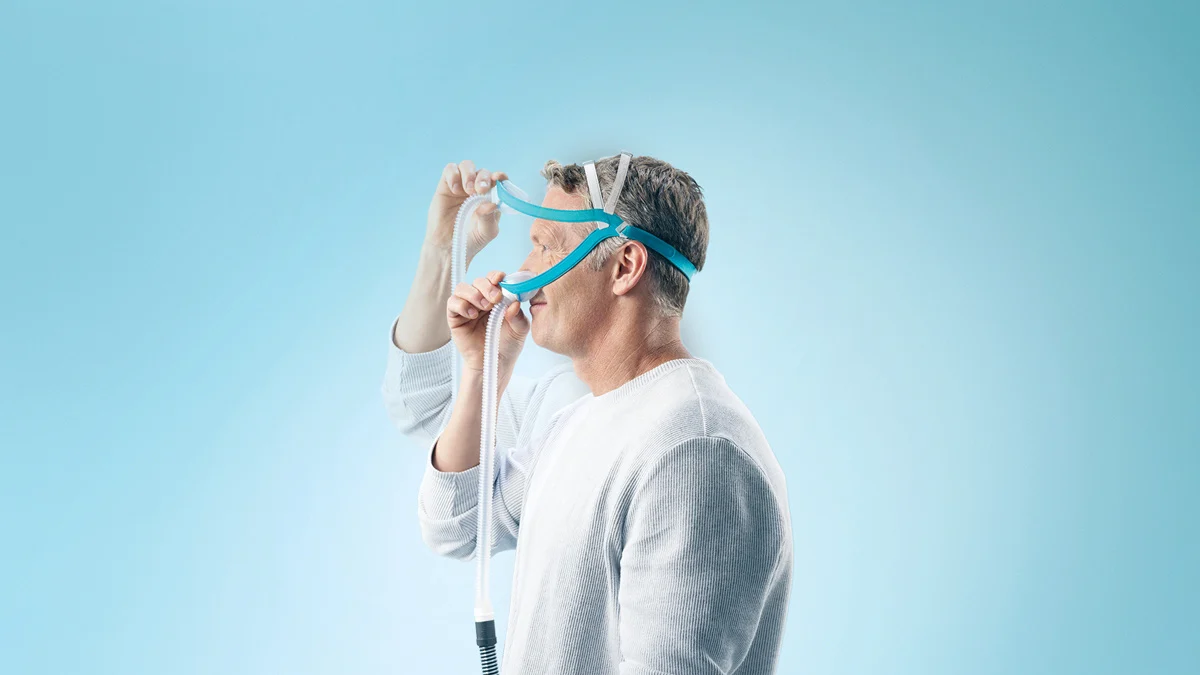Here’s How You Can Stop Leaks and Get a Better Night’s Sleep.
CPAP (continuous positive airway pressure) has long been considered the most effective treatment for sleep apnea.
Yet, one of the most frequent complaints we hear from CPAP users is that their mask leaks. How do they know? They say when they exhale, they feel air rush into their eyes, drying them out. Or they hear a hissing or whistling noise, which bothers their bed partner. Or they wake with a dry mouth or sore throat.
Mask leaks can be a significant problem. In fact, studies show that 45% of former CPAP users stopped their treatment because of mask leaks.
Stopping use of your CPAP mask is not the solution. “To effectively treat your sleep apnea, you should use your CPAP machine every night,” says Robert Miller, Apria Healthcare Vice President of Sleep Business.
Following are simple tips to fix the most common reasons for mask leaks.
1. Clean Your Mask
How to fix: If your mask used to fit well but now leaks, facial oil or dirt may be compromising the seal. That’s why it’s important to regularly clean your mask.
Once you get into the habit, cleaning your mask (as well as your CPAP machine) is a snap. And you can use supplies you have in your home, such as warm, clean water; mild soap or baby shampoo; clean, dry towels; and a sink or tub to hold the items you are cleaning.
You should clean your CPAP mask—including the cushion, headgear, and frame—every day. You should also clean CPAP filters, tubing, and the humidifier once a week.
This will reduce the risk of leaks and prevent the buildup of bacteria, mold, dust, and germs, which may cause such conditions as pneumonia or sinus infections. Learn more about the dos and don’ts of CPAP cleaning.
Apria’s Robert Miller adds, “One more tip: washing your face before you put on your mask helps form a better seal.”
2. Put on Your Mask After Lying Down
How to fix: The mask seals fine when you first put it on, but then the seal breaks when you sleep. This may be because facial muscles relax once you fall asleep, which can change the shape of your face.
Try putting the mask on when you are in the sleeping position.
3. Adjust the Fit After Lying Down
How to fix: Your mask should fit snugly—not overly tight, not overly loose. It also shouldn’t cause headaches or pain or leave marks on your face after you’ve been awake for more than two hours.
Adjust your mask when you are lying down since your face shape is different from when you stand or sit. Then tighten the straps until your mask feels snug and secure.
4. Make Sure Your Mask Is Right for Your Sleeping Position
How to fix: We all have different facial structures. Before you purchase a mask, try on a variety of styles and sizes to find the one that best fits your face. Be sure to try them on lying down.
We also have our favorite sleeping position. But one mask isn’t appropriate for all. Here are mask recommendations for a variety of sleeping positions:
- Side sleepers: A nasal mask or nasal pillow mask is recommended. If you need a full-face mask, choose one that has a sleeker design with smaller cushions.
- Stomach sleepers: A nasal pillow mask is the most appropriate. Because these masks have a low profile, they are less likely to become dislodged or cause pain.
- Back sleepers: Most doctors don’t recommend sleeping on your back if you have sleep apnea. But if you must sleep on your back, doctors recommend a nasal mask, an under-the-nose mask, or a full-face nasal pillow.
- Mouth breathers: A full-face CPAP mask is an excellent choice. For those who can’t sleep with that type of mask, a popular alternative is a chin strap paired with a nasal mask or a nasal pillow CPAP mask.
- Nose breathers: Any type of mask (except an oral mask) helps ensure effective treatment.
- Active sleepers: Choose a mask that has connections at the top of the head to help prevent the hose from becoming entangled as you move during sleep.
- People with a deviated septum: An oral CPAP mask is most appropriate.
Learn more about choosing the right CPAP mask for your sleeping position.
5. Discuss Your CPAP Air Pressure With Your Doctor
How to fix: Your CPAP machine delivers pressurized air to keep your airways open and help you breathe—and sleep—more easily. Your doctor will prescribe your air pressure setting. But studies show that high air pressure can cause masks to break their seal, which leads to leakage. Talk with your doctor about adjusting your air pressure settings.
Also, if your CPAP machine has a ramp feature, use it. This starts at a low pressure and then gradually increases it to your prescribed pressure setting as you sleep.
6. Replace Your Cushion or Mask
How to fix: Sometimes, just cleaning your mask doesn’t do the trick. You may need to replace the cushion and even the mask itself.
At Apria, we’re here to help. We have several convenient ordering options to keep your CPAP supplies fresh. Learn more now!
References
1. Summer, J. (2022, November 8). Common Side Effects of CPAP. Sleep Foundation. https://www.sleepfoundation.org/cpap/cpap-side-effects#:~:text=Mask%20leaks%20can%20occur%20when,or%20does%20not%20seal%20well.
2. Junkin, M. (2020, July 10). Annoyed by CPAP mask leaks? Try these 6 fixes.
Vancouver Clinic. https://tvc.org/news/cpap-mask-leaks/.
3. CPAP Mask Leak Problems: How To Prevent CPAP Mask Leakage.
Sleep Apnea Guide. https://www.sleep-apnea-guide.com/cpap-mask-leak.html.
4. Sellman, K. (2023 January). How to Conquer CPAP Leaks: Tips and Tricks.
SleepApnea.Sleep-Disorders.net. https://sleepapnea.sleep-disorders.net/living/tips-cpap-leaks.
5. Common CPAP complaint: My CPAP mask leaks. ResMed. https://www.resmed.com/en-us/sleep-apnea/sleep-blog/common-cpap-complaint-my-cpap-mask-leaks/.
LEGAL DISCLAIMER: Material in this newsletter is provided for general health education and informational purposes and to provide references to other resources only; it may not apply to you as an individual. While Apria Healthcare believes that the information provided through this communication is accurate and reliable, Apria Healthcare cannot and does not make any such guarantee. It is not intended to be a replacement for professional medical advice, evaluation, diagnosis, services or treatment (collectively, “medical treatment”). Please see your healthcare provider for medical treatment related to you and your specific health condition(s). Never disregard medical advice or delay seeking medical care because of something you have read on or accessed through this website. Reading this newsletter should not be construed to mean that you have a healthcare provider/patient relationship.





